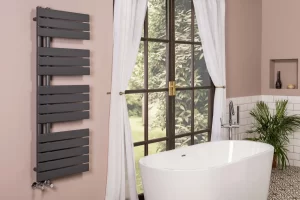 Your bathroom is a space where you begin and end your day, a sanctuary of relaxation and rejuvenation. However, without proper ventilation, it can quickly turn into a damp, stuffy, and unpleasant environment.
Your bathroom is a space where you begin and end your day, a sanctuary of relaxation and rejuvenation. However, without proper ventilation, it can quickly turn into a damp, stuffy, and unpleasant environment.
Today, we will explore the importance of arranging proper ventilation for your bathroom and provide practical tips to ensure a breath of fresh air every time you step inside.
Understanding the Importance of Bathroom Ventilation
- Enhancing Air Quality. Adequate ventilation helps remove excess moisture, odors, and pollutants from your bathroom, maintaining a healthier and more pleasant environment.
- Preventing Mold and Mildew. Moisture accumulation in bathrooms can lead to the growth of mold and mildew, which not only affects the aesthetics but also poses potential health risks.
- Preserving Structural Integrity. Consistent moisture levels can cause damage to walls, ceilings, and fixtures over time. Proper ventilation helps mitigate these risks and prolongs the lifespan of your bathroom.
Assess the Existing Ventilation
Determine if your bathroom already has a ventilation system in place. Look for exhaust fans, windows, or other means of air circulation.
If there is an existing system, check its functionality and effectiveness.
Choosing the Right Ventilation System
- Exhaust Fans. Consider installing an exhaust fan to efficiently remove moist air and odors. Look for a fan with sufficient airflow capacity for the size of your bathroom.
- Fan Placement. Position the exhaust fan near the shower or bathtub, where moisture levels are highest. This ensures effective ventilation and prevents condensation on surfaces.
- Size. Choose an exhaust fan that is appropriately sized for your bathroom. The fan’s capacity is measured in cubic feet per minute (CFM), indicating how much air it can move.
- Ventilation Ducts. Connect the exhaust fan to an exterior vent using ventilation ducts. The ducts should be properly sealed and insulated to prevent air leaks. The vent should be placed in a location that allows the expelled air to flow freely outside without causing any issues, such as near windows or neighboring vents.
Regular Maintenance
Dust, debris, and accumulated moisture can reduce the effectiveness of the ventilation system. Clean the fan blades, replace filters if applicable, and clear any blockages in the ducts.
Natural Light and Fresh Air
If possible, incorporate natural ventilation into your bathroom design. Install windows or skylights to allow fresh air circulation. These elements promote airflow and create a more inviting space. However, be mindful of privacy and security concerns when adding windows.
Dehumidifiers
In addition to exhaust fans, you can also use other ventilation aids such as dehumidifiers, air purifiers, or moisture-activated switches. These can help maintain optimal air quality and moisture levels in the bathroom.
Remember to comply with local building codes and regulations regarding bathroom ventilation. If you’re unsure about the installation process or need specific advice, consult a professional contractor or electrician who can guide you through the process.
Picture Credit: Freepik
